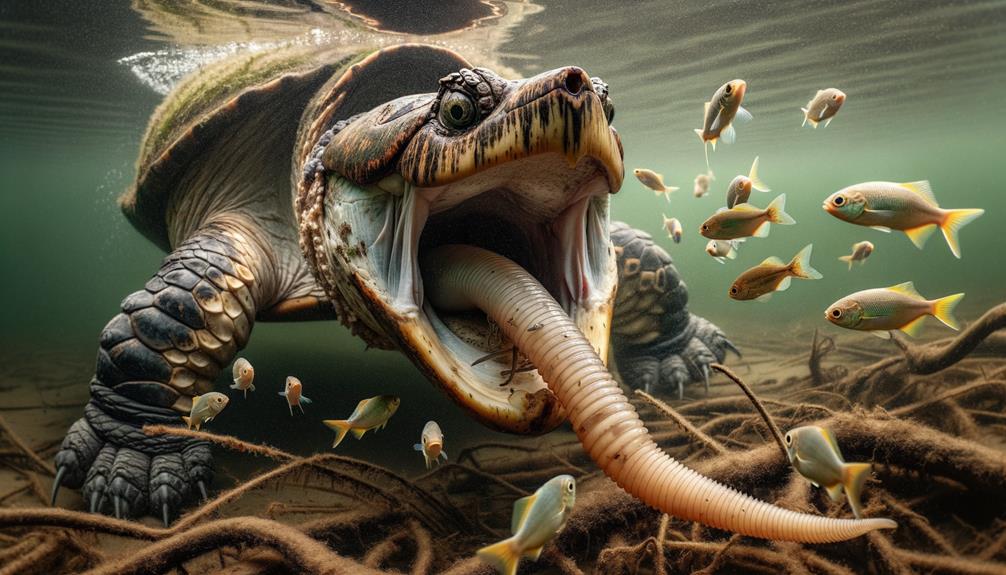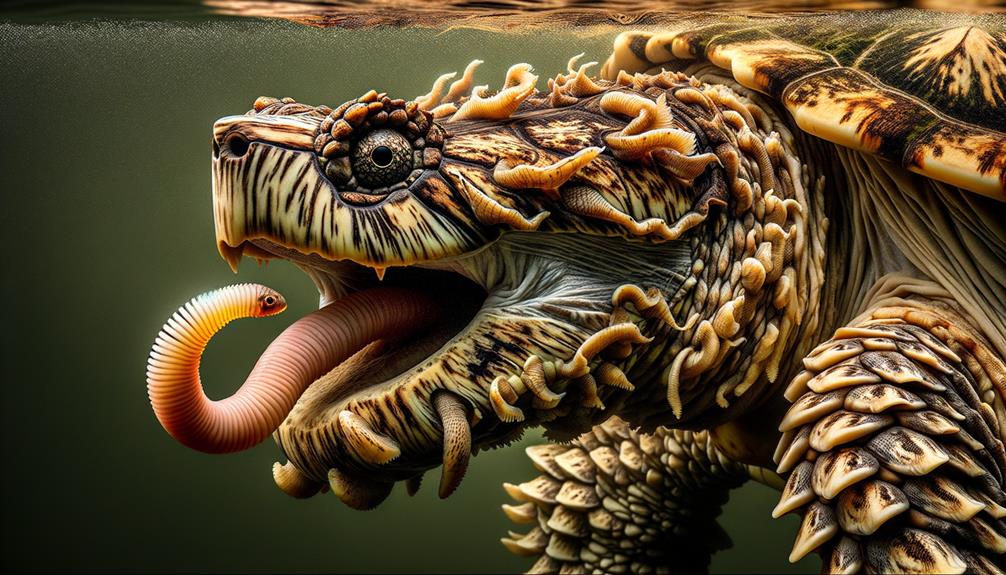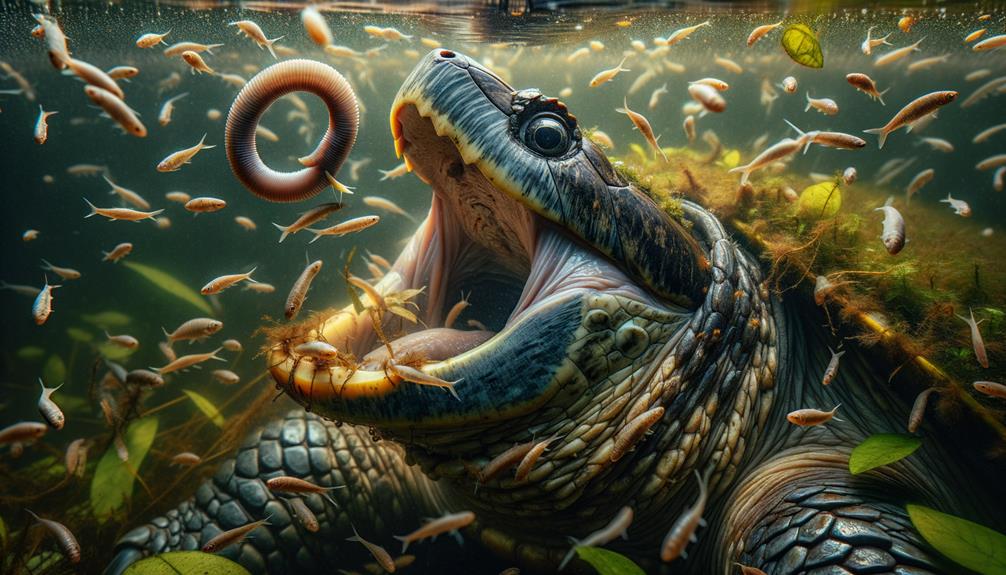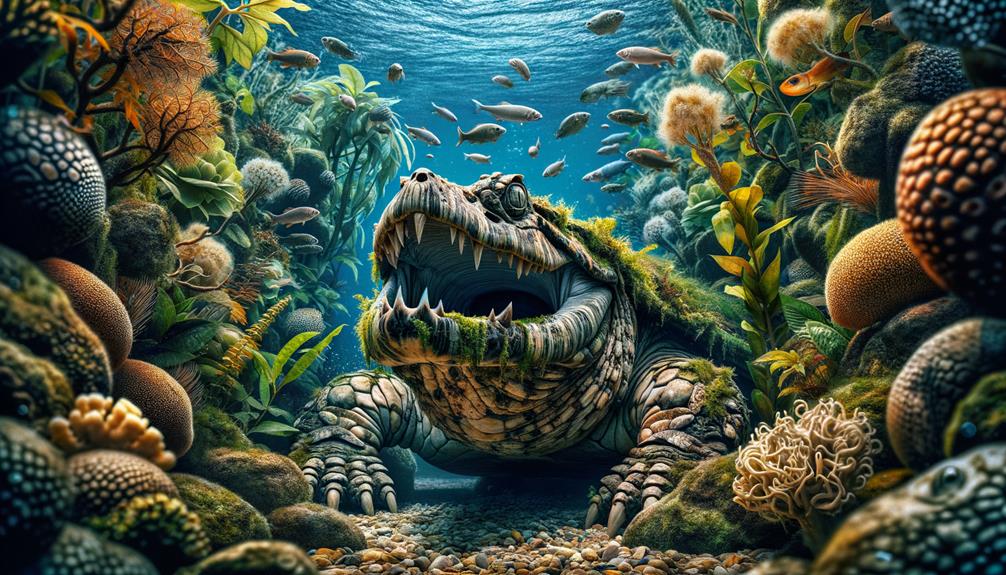I find the alligator snapping turtle's luring tongue utterly captivating – a true marvel of evolutionary adaptation. Picture a turtle, completely still and seemingly harmless, while its tongue, a blood-filled appendage, mimics the movements of a wriggling worm. This clever tactic lures fish and other small creatures into the turtle's gaping maw. The precision of this tactic is astounding, but what intrigues me even more is the evolutionary journey that led to such a specialized hunting technique. What secrets might this ancient reptile hold within its rugged shell?
Anatomy of the Luring Tongue
The alligator snapping turtle's tongue is a masterful tool for catching prey. It features a blood-filled, worm-like appendage that it skillfully wriggles to lure unsuspecting fish and small creatures. This adaptation, known as lingual luring, is a remarkable example of nature's ingenuity. When I observed this, I was struck by how convincingly the tongue mimics the erratic movements of a worm. The turtle remains still, its mouth open, while its tongue dances enticingly, drawing prey into its deadly trap.
What sets the alligator snapping turtle apart is not just its worm-like tongue, but how it works in tandem with other parts of its body. The turtle's rugged, mossy shell and camouflaged appearance add to the illusion, making it seem like a harmless part of the environment. By combining these features, the turtle increases its chances of a successful hunt. Even young alligator snapping turtles demonstrate this technique, proving its effectiveness from an early age.
The alligator snapping turtle's hunting strategy is even more impressive when you consider that it often uses its tongue in combination with caudal luring, where it uses its tail to attract prey. This multifaceted approach showcases the turtle's adaptability and the remarkable evolution of its hunting strategies.
Hunting Technique in Action

In the murky waters of North America's rivers and lakes, the alligator snapping turtle is a master of stealth, using its unique hunting technique to catch its prey. The turtle remains almost motionless, holding its breath for up to 50 minutes, waiting for the perfect moment to strike. Its secret weapon is a blood-filled, worm-like appendage on its tongue that it wriggles convincingly to mimic the movements of a small worm.
Young alligator snapping turtles are experts at this technique, using their tongues to lure unsuspecting fish into their gaping jaws. The turtle's body remains still, creating an illusion of harmlessness. In captivity, juveniles have been observed perfecting this method, demonstrating that this skill is both innate and refined over time.
The lure is often enhanced by subtle movements of other body parts, making the deception even more convincing. This form of aggressive mimicry is not unique to the alligator snapping turtle, but its execution is remarkably efficient. As fish swim closer, drawn by the promise of an easy meal, they find themselves ensnared by the turtle's powerful bite, a testament to nature's ingenuity and the turtle's predatory prowess.
Evolutionary Advantage

Boasting an incredible survival strategy, alligator snapping turtles have perfected their lingual luring technique to catch prey with unmatched efficiency. This clever method involves their worm-like tongue appendage, which wiggles convincingly to mimic live bait, drawing in unsuspecting fish and amphibians. It's fascinating to observe how these turtles have adapted their hunting strategy to thrive in both aquatic and terrestrial environments.
By using their specialized tongue, alligator snapping turtles lure prey effectively, transforming a simple appendage into a sophisticated tool. This remarkable adaptation not only showcases the turtle's adaptability but also its remarkable ability to thrive in its environment. Even young turtles in captivity instinctively master this technique, demonstrating its instinctual nature.
- Versatile Hunters: Effective in both water and on land.
- Natural Deception: Tongue resembles a wriggling worm.
- Instinctive Mastery: Captive juveniles use it without trouble.
- Survival Advantage: Outcompetes species without this trait.
- Multi-Species Technique: Similar luring seen in snakes like puff adders.
In essence, the alligator snapping turtles' lure strategy offers them a significant survival advantage, ensuring they rarely struggle to catch prey. For these turtles, it's not just about surviving – it's about dominating their niche with remarkable evolutionary ingenuity.
Role in the Ecosystem

By playing a vital role as both predators and scavengers, alligator snapping turtles maintain the delicate balance within their aquatic ecosystems. These magnificent creatures are like the silent guardians of the water, ensuring that both prey and decaying matter are kept in check. I often marvel at how their presence influences the environment around them.
Their diet consists of fish, amphibians, and even other turtles, which helps regulate these populations and prevent overgrazing of aquatic vegetation. Additionally, by consuming carrion, they help recycle nutrients back into the ecosystem, keeping the water clean and balanced.
Here's a glimpse into the emotional impact of their role:
| Predator | Scavenger |
|---|---|
| Controls prey populations | Cleans up dead matter |
| Prevents overgrazing | Recycles nutrients |
| Balances aquatic life | Maintains water quality |
Imagine a world where these ancient reptiles no longer exist. Overpopulation of prey species would lead to a collapse of the delicate aquatic flora. Decaying matter would accumulate, turning pristine waters into murky swamps. The alligator snapping turtle, though often misunderstood, is a guardian of our waterways, ensuring the harmony and freedom of life beneath the surface.
Observations From Aquariums

One fascinating observation I've made at various aquariums is how alligator snapping turtles use their unique, worm-like tongues to lure unsuspecting prey into their powerful jaws. Watching this predatory behavior unfold in a controlled environment is both mesmerizing and enlightening. The Flint RiverQuarium, for instance, features Big Al, an impressive alligator snapping turtle who skillfully uses his tongue to mimic the wriggling motion of a worm, drawing in curious fish.
The Tarpon Springs Aquarium also offers engaging educational content, including videos that showcase this fascinating feeding strategy. These demonstrations not only entertain but also educate visitors about the intricacies of marine life behaviors.
Big Al at Flint RiverQuarium is a remarkable example of the alligator snapping turtle's lure technique. The Tarpon Springs Aquarium videos provide engaging content showcasing the turtle's feeding habits. The Flint RiverQuarium's efforts to stimulate and engage their animals through enrichment activities are commendable. Aquariums offer deeper insights into marine life and their ecosystems, highlighting the importance of understanding these complex environments. Observing similar predatory tactics in different species, like garter snakes, underscores the significance of these educational institutions.
These observations highlight the value of aquariums in promoting a deeper understanding of aquatic creatures, revealing the subtle yet powerful methods they employ to survive in the wild.
Conservation Efforts

When I think about safeguarding the alligator snapping turtle, three key strategies come to mind. To ensure these incredible creatures continue to thrive, we need to focus on habitat protection, captive breeding programs, and public awareness campaigns. Let's take a closer look at each of these efforts and how they're making a difference.
Habitat Protection Strategies
Protecting the alligator snapping turtle's habitat requires a thoughtful approach that combines legal safeguards, community engagement, and scientific research. Each element plays a crucial role in ensuring these ancient reptiles have a safe and sustainable environment.
First and foremost, legal protections are vital. Designating critical habitats and enforcing anti-poaching laws form the basis of these efforts. However, laws alone are insufficient. Community engagement is necessary to foster a sense of responsibility among local residents. When people understand the importance of these turtles to their ecosystem, they are more likely to take action.
Scientific research provides the necessary data to make informed decisions. By studying the turtles' behaviors, migration patterns, and breeding habits, scientists can develop targeted conservation strategies.
To effectively protect the alligator snapping turtle's habitat, we need to:
Enforce laws to safeguard critical habitats and prevent poaching.
Educate and engage local communities to promote awareness and involvement.
Restore and preserve natural habitats that these turtles rely on.
Conduct scientific studies to understand the species' needs and threats.
Collaborate with conservation organizations to maximize impact.
Captive Breeding Programs
Captive breeding programs can significantly impact the conservation of alligator snapping turtles in our increasingly threatened ecosystems. These initiatives are crucial for boosting population numbers and reducing pressure on wild populations. The Flint RiverQuarium, for instance, not only showcases Big Al, an impressive alligator snapping turtle, but also engages in desensitization training for Atlantic sturgeons, highlighting the multifaceted role of aquariums in conservation efforts.
In captivity, fascinating behaviors have been observed, such as juvenile alligator snapping turtles using lingual luring, demonstrating their innate survival skills. This underscores the potential of these programs to prepare turtles for eventual release into the wild.
Institutions like the Tarpon Springs Aquarium play a vital role in promoting conservation efforts by sharing educational content, informing the public about the importance of breeding programs and their broader ecological impact.
Recognizing new species, as suggested by a 2014 study, can refine conservation strategies. Addressing species-specific needs ensures more effective protection. As a result, captive breeding programs are a fundamental component of a comprehensive conservation strategy.
Public Awareness Campaigns
By running public awareness campaigns, we can greatly increase the impact of captive breeding programs and promote a deeper understanding of the ecological significance of alligator snapping turtles. These ancient reptiles play a vital role in their habitats, and their survival is crucial. When people are educated about these turtles, they're more likely to support conservation efforts, contribute financially, and participate in meaningful actions.
I've seen the power of awareness campaigns to inspire a passion for conservation. We need to highlight the unique feature of the alligator snapping turtle's tongue, which mimics a worm to attract prey, as a symbol of nature's ingenuity. Educational workshops at schools and community centers can teach people about the turtle's role in the ecosystem. Social media campaigns using platforms like Instagram and Facebook can share fascinating images and stories. Partnerships with influencers can help reach a broader audience. Documentaries and short films can produce visually stunning content to showcase the turtles' lives and conservation needs. Volunteer programs can encourage community involvement through habitat clean-ups and monitoring projects.
It's time for us to become guardians of these incredible creatures.
Frequently Asked Questions
What Is the Lure in the Mouth of an Alligator Snapping Turtle?
I find the lure in an alligator snapping turtle's mouth fascinating. It's a worm-like, blood-filled appendage that wriggles to attract prey. The turtle stays completely still, turning its mouth into an irresistible trap for unsuspecting fish.
How Does an Alligator Snapping Turtle Lure Its Prey?
I watch the alligator snapping turtle patiently waiting for its next meal, its worm-like tongue wriggling enticingly. The turtle remains still, its open mouth a trap waiting to snap shut on unsuspecting fish that swim too close.
What Is the Mimicry of the Alligator Snapping Turtle?
The alligator snapping turtle has a cunning trick up its sleeve – or rather, on its tongue. It uses lingual luring to mimic a worm, cleverly deceiving fish into its deadly grasp. This remarkable tactic is a testament to the turtle's resourcefulness and adaptability in the wild.
Why Do Alligator Snapping Turtles Keep Their Mouth Open?
I find that alligator snapping turtles keep their mouths open to reveal their worm-like tongue, luring prey into their trap. This clever tactic lets them remain still and silent, efficiently capturing food in their aquatic environment where every meal counts.



